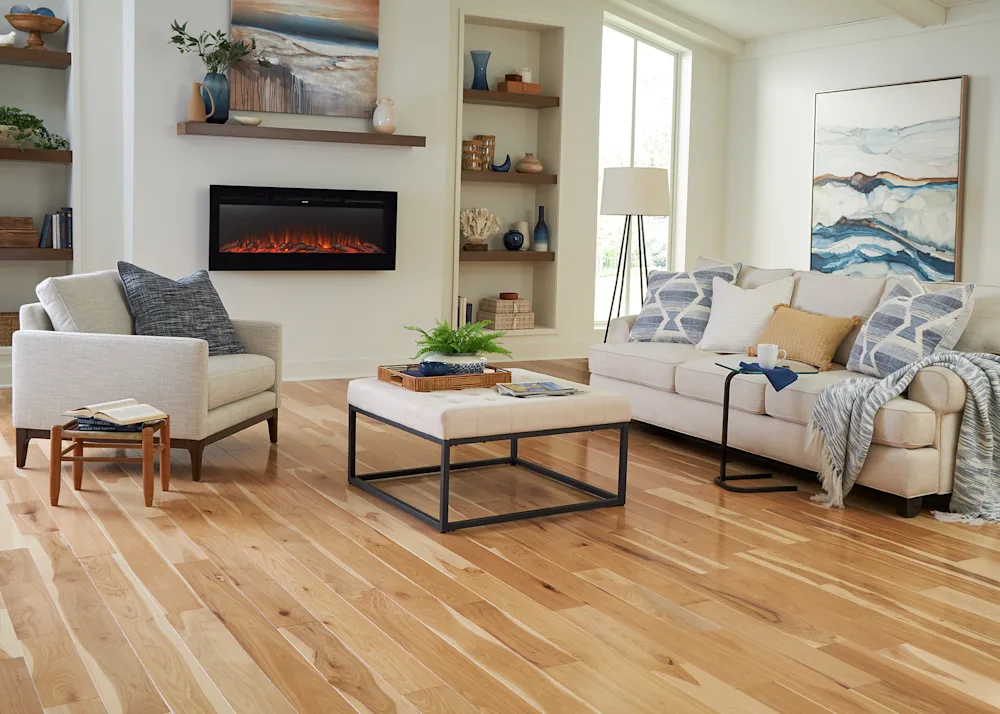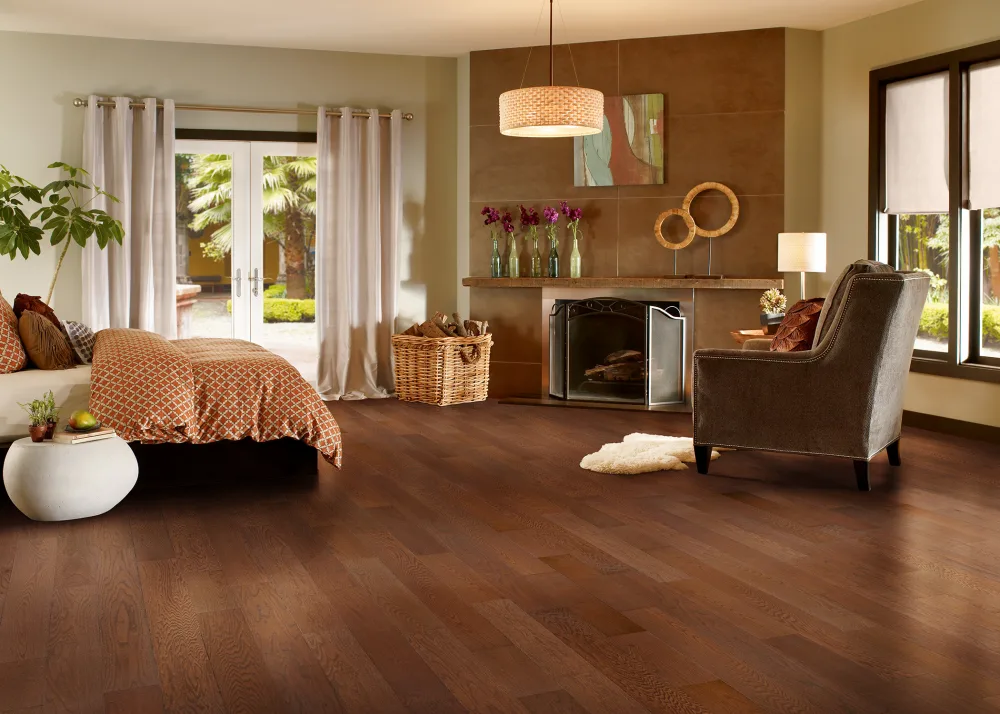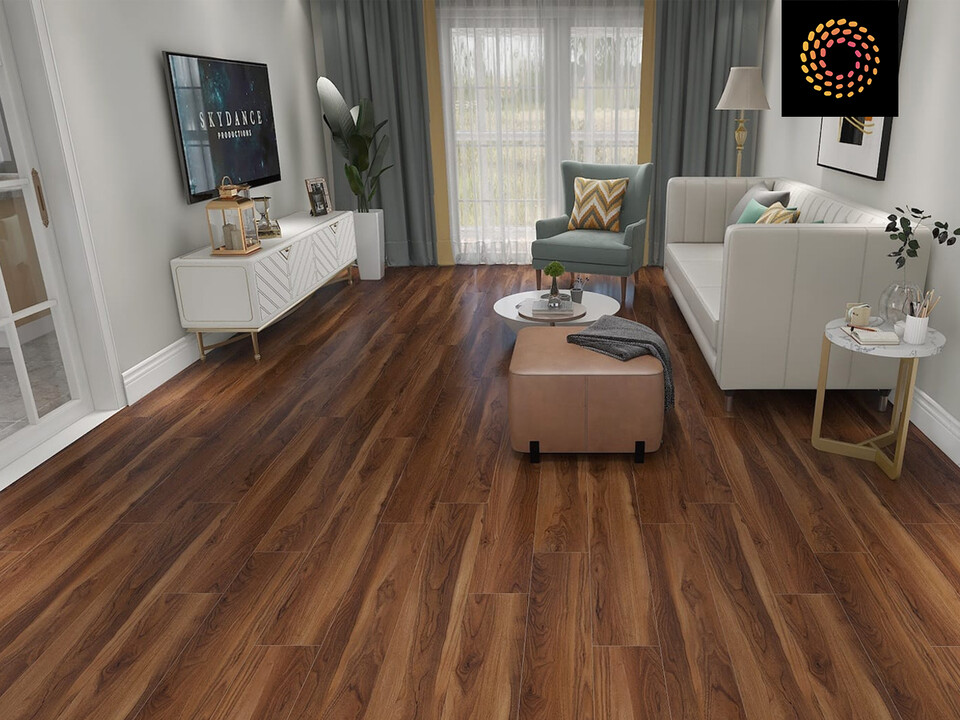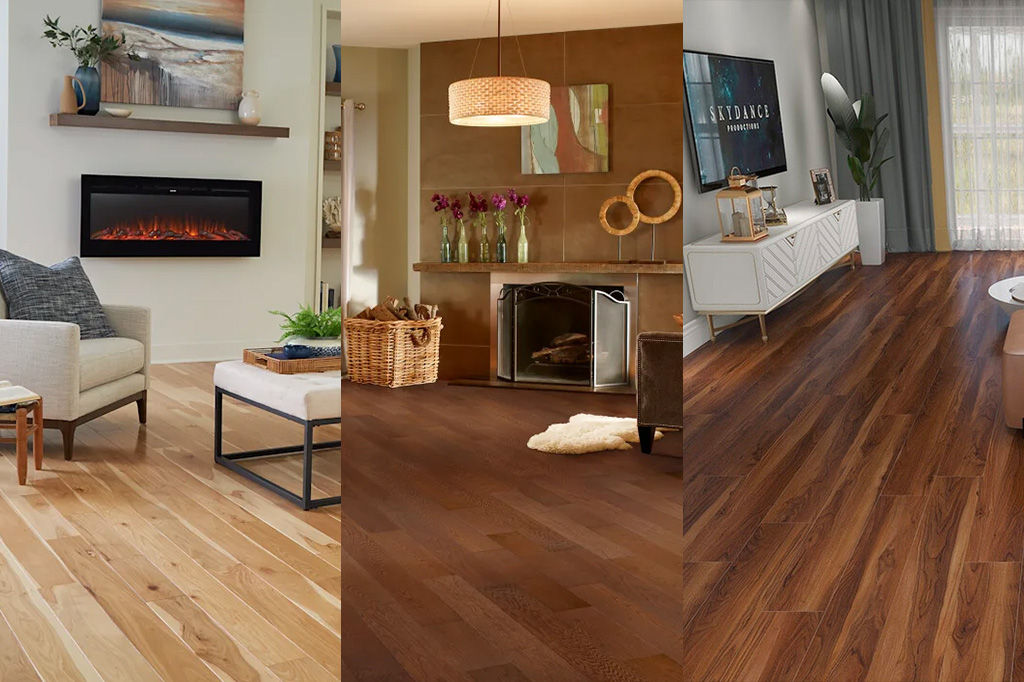When selecting flooring, numerous options exist, each with unique advantages and disadvantages. Among these are solid wood, engineered wood, and SPC (Stone Plastic Composite) flooring. It’s important to grasp the characteristics of each to determine which one best fits your needs.
Table of Contents
ToggleSolid Wood Flooring

Solid wood flooring represents the pinnacle of classic style, crafted from robust 3/4-inch thick hardwood such as oak or cherry. Its charm is rooted in its natural beauty, displaying unique grain patterns and warm tones that imbue spaces with a traditional and welcoming ambiance.
This type of flooring can endure the test of time because it can be sanded and refinished numerous times, rejuvenating its original sheen while extending its lifespan. However, solid wood is prone to moisture damage and warping in damp conditions, making it most suitable for rooms with consistent temperature and low humidity.
Pros | Cons |
|
|
Engineered Wood Flooring

Engineered wood flooring is a flexible and robust choice, featuring a wood veneer layer atop a core composed of plywood or high-density fiberboard (HDF). This layered construction provides greater stability than solid wood, reducing the risk of warping or contracting due to moisture or temperature fluctuations. Although engineered wood can be sanded and refinished to maintain its appearance, it doesn’t offer as many refinishing opportunities as solid wood.
However, engineered wood flooring is available in a wide range of styles and finishes, allowing it to suit various aesthetic preferences. This flooring option is cost-effective for most parts of a home, including areas like basements, where moisture levels might be higher.
Pros | Cons |
|
|
SPC Flooring

SPC (Stone Plastic Composite) flooring is recognized for its outstanding durability and solid build quality. The heart of SPC flooring consists of a mix of limestone powder and stabilizers, resulting in a strong and stable core. This is topped with a layer of vinyl and a tough wear layer that defends against scratches, stains, and moisture, making it a reliable choice for busy and wet environments such as kitchens and bathrooms.
The installation process for SPC flooring is user-friendly, generally involving a click-lock system that simplifies the setup. It also demands little maintenance, adding to its practicality. SPC flooring is also highly customizable, capable of replicating the look of various natural materials like wood, stone, or ceramic tile, which allows it to fit a wide range of decorative styles.
Pros | Cons |
|
|
Aesthetic Appeal Comparison
Solid Wood Flooring
- Authentic Beauty: Enjoy the natural grain patterns and finishes of real wood.
- Long-Lasting Appearance: Solid wood maintains its beautiful, natural look over time.
Engineered Wood Flooring
- Variety of Species and Finishes: Choose from numerous wood species and finishes.
- Mimics Solid Wood: Designed to replicate the appearance of solid wood flooring.
SPC Flooring
- Realistic Looks: Offers lifelike wood and stone appearances.
- Customization Options:Available for custom customization in a variety of hues and textures.
Durability and Longevity Comparison
Solid Wood Flooring
- Long-Term Durability: Offers a significant lifespan with proper maintenance.
- Handles Wear and Tear: Highly effective in resisting wear, scratches, and dents.
Engineered Wood Flooring
- Stable Performance: Performs well under varying moisture and temperature conditions.
- Durable Construction: The veneer layer and core materials provide lasting durability.
SPC Flooring
- Water Resistance: Excellent water-resistant properties.
- Robust Durability: It is appropriate for high-traffic locations since it can withstand wear, impact, and heavy use.
Maintenance and Care of Different Flooring Types
Solid Wood Flooring
- Regular Care: Requires cleaning, sanding, and occasional refinishing to maintain its appearance.
- Moisture Sensitivity: Susceptible to moisture and wear, requiring careful maintenance.
Engineered Wood Flooring
- Maintenance Needs:Requires routine cleaning; compared to solid wood, less frequent sanding and refinishing.
- Scratch and Moisture Susceptibility: Can be prone to scratches and moisture, necessitating careful care.
SPC Flooring
- Low Maintenance: Easy to clean with minimal maintenance required.
- High Resistance: Resistant to stains, spills, and scratches, making it a practical choice for busy households.
Cost and Value Comparison
Solid Wood Flooring
- Price Range: Generally higher cost due to the use of natural wood; price varies based on wood species and quality.
- Value for Money: Offers excellent value with the potential for refinishing, extending its lifespan and maintaining its appeal.
Engineered Wood Flooring
- Average Cost: Typically less expensive than solid wood; costs vary based on wood species, veneer thickness, and core materials.
- Investment Considerations: Provides good value with a balance of aesthetic appeal and durability, making it a worthwhile investment.
SPC Flooring
- Cost Range: Known for its affordability; costs are generally lower compared to wood flooring options.
- Long-Term Savings: Offers great value for money with its durability, easy maintenance, and resistance to damage, leading to reduced long-term maintenance costs.
Installation of Different Flooring Types
Solid Wood Flooring
- Installation Methods: Typically installed using nail-down or glue-down methods.
- Complexity: More complex installation process, often requiring professional expertise; not generally suitable for DIY due to the need for specialized tools and skills.
Engineered Wood Flooring
- Installation Methods:Installing it is possible with floating, nail-down, or glue-down techniques.
- Ease of Installation: Easier to install compared to solid wood; floating installation is more DIY-friendly, though professional installation is recommended for the best results.
SPC Flooring
- Installation Methods: Commonly installed using click-lock or glue-down methods.
- DIY Suitability:Especially with click-lock systems that make installation simple and fast without the need for glue or nails, it’s very do-it-yourself friendly.
Choosing the Right Flooring for Your Needs
1. Room Conditions
Moisture Levels:
- Solid Wood: Best in low-moisture areas (e.g., living rooms, bedrooms).
- Engineered Wood: Suitable for moderate moisture levels (e.g., kitchens, basements).
- SPC Flooring: Ideal for high-moisture areas (e.g., bathrooms, laundry rooms).
Traffic:
- Solid Wood: Excellent for low to moderate traffic areas.
- Engineered Wood: Good for moderate to high traffic areas.
- SPC Flooring:Its resilience makes it ideal for places with heavy traffic.
Aesthetic Preferences and Design Goals
- Solid Wood: Offers authentic beauty and a timeless, natural look.
- Engineered Wood: Provides a variety of species and finishes, mimicking solid wood.
- SPC Flooring: Delivers realistic wood and stone looks with customizable colors and textures.
Budget and Long-Term Investment
- Solid Wood: Higher upfront cost but offers excellent long-term value with refinishing potential.
- Engineered Wood: Moderately priced with good durability and aesthetic appeal.
- SPC Flooring: Most affordable option with long-term savings due to low maintenance needs.
2. Practical Tips
- High Moisture Areas: Choose SPC Flooring for its water resistance and durability.
- Heavy Traffic Areas: Opt for SPC Flooring or Engineered Wood for their resilience to wear and tear.
- Aesthetic Goals: Select Solid Wood for a classic, natural look; Engineered Wood for variety and versatility; SPC Flooring for modern, customizable designs.
- Budget-Friendly Option:The ideal combination of price and long-term savings is provided by SPC Flooring.
- Low Maintenance Preference:One of the easiest types of flooring for busy households to maintain is SPC flooring.
Conclusion
Ultimately, the optimal flooring choice hinges on individual needs and preferences. Those seeking a timeless, natural aesthetic with a willingness to undertake additional upkeep may find solid wood flooring most suitable. For those prioritizing stability, moisture resistance, and visual appeal, engineered wood flooring might be preferable. Conversely, individuals placing a premium on durability and waterproof qualities may find SPC flooring to be the ideal option for their homes.

